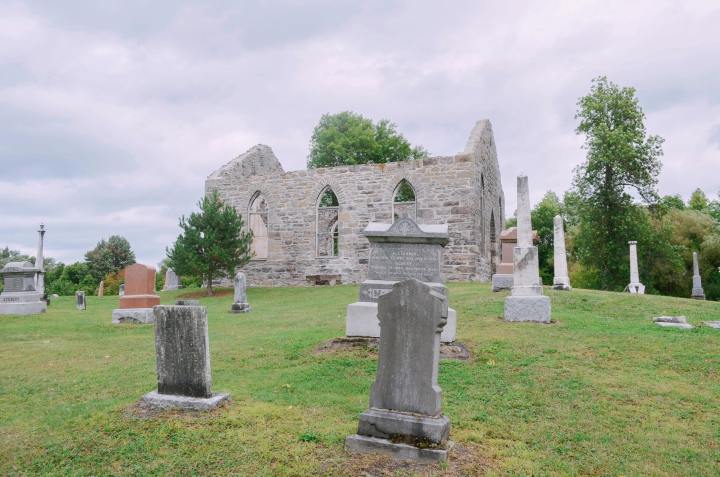
Dear friends, I am so excited to write about the story of an abandoned village, Rivière de La Guerre, located in the province of Quebec, where Scottish settlers began to come over from the Hebrides Archipelago, west of the Highlands.
Originally, the area was called Godmanchester. Named after a man known as Francois dit La Guerre, a settler that had been living in the village at the time, Riviere de la Guerre only survived for about 30 years before being completely abandoned by the 1850’s.
Riviere de la Guerre had over 80 inhabitants from 16 families making up the citizens of the village. Things were going well for a few years with the agriculture and forestry businesses thriving and the citizens had access to a shoemaker, several different shops, and even a schoolhouse making life quite enjoyable in the little village.

Today, on Chemin de la Rivière-La Guerre, a sign indicates the location of the ruins. Still standing, the old Protestant church which has lost its roof, surrounded by a Scottish cemetery and the presbytery in poor condition. A rank school is also always visible, even if it has partially collapsed on itself.
The McDonald mansion is the only building still inhabited. It was built in 1837 by John McDonald, who became master after marrying the widow of Alexander McBain, the founder of the village. The manor served as a general store and even a post office for a few years.
Donald Irving lives in the McDonald mansion. His family, also of Scottish origin, bought the lots from the old village a hundred years ago.
My grandfather, he says in English, had agreed to maintain a right of way so that people could go to the old church and the cemetery.
Hidden away from the road, down a bumpy trail through a corn field, we can find the remains of this long abandoned village. The site is accessible to the public, even if it is surrounded by the land of a farmer who acts as guardian of the premises.
Reasons for the abandonment of the village
Alexander McBain, founder of the village, had built his business on logging. The exhaustion of the noble tree species therefore put an end to the economic vitality of the place.
Subsequently, the advent of the steamboat, which could not go up the La Guerre river, favored the development of Saint-Anicet, located 4 kilometers further north on the shores of Lake Saint-François.
The final ‘coup de grace’ came around 1850 with the construction of dikes to facilitate navigation on the St. Lawrence. The building of the Beauharnois canal ended up causing the downfall of the village not long after it’s construction, when the waters rose too high and flooded a good portion of the village.
With no other option but to abandon ship, the villagers’ packed up their belongings and simply moved onto the next town, leaving behind the buildings that we see today.
Ghost Hunters
At that time, nobody came here. But now there are always people, even at night, because it is said that the place is haunted. It was found on the websites of ghost hunters and lovers of paranormal phenomena. And they believe that nobody lives here.
~Donald Irving
The site occasionally attracts descendants of Scottish families buried here, history buffs and photography buffs. Night visitors even vandalized the oldest gravestones in the cemetery.
After the pandemic, I’d love to visit the site, but will not go alone that’s for sure 🙂
Until next, stay strong, stay safe!
Janice
Sources : RadioCanadaPodcast | Radio-Canada-Article


hello im a beginner explorer and this location is on my list to go out. in your notes it says there is a sign that tells us how to get to the abandoned village could you give me more details on where the sign is? like on what street corner and if i need to speak to anyone? because you said The site is accessible to the public, even if it is surrounded by the land of a farmer who acts as guardian of the premises. i wouldn’t want to accidently drive into the wrong persons field. thanks